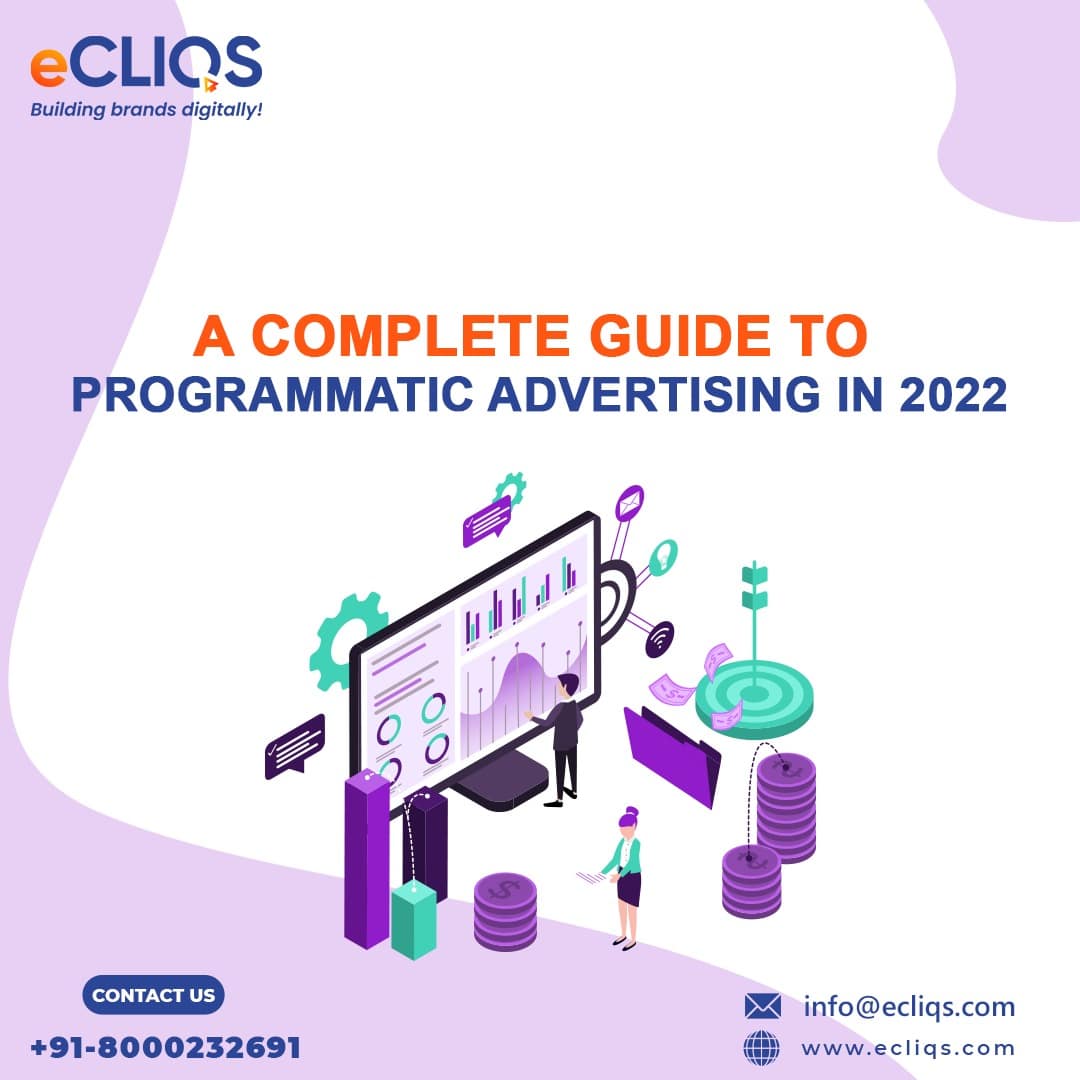
Many people who work in digital marketing are still unsure of what programmatic advertising actually entails. Programmatic ad buying is complex since it combines data science, automation, and machine learning. It is easy to get lost in the sea of acronyms and buzzwords that surrounds programmatic marketing and think that everyone involved is speaking a foreign language.
There is a lot of misinformation floating around about what programmatic advertising actually is and why your company should consider using it.
What Is Programmatic Advertising?
Automatic buying and selling of online advertising space is known as programmatic advertising.
In the beginning of the era of online advertising, we handled digital advertising transactions in the same way as buying print advertising. Advertisers would pay a premium to have their advertising displayed on a popular website, and publishers would be willing to sell that space for a price.
There was a lot of waste in the system. Ad space management was a frequent source of contention between buyers and sellers. It was challenging to execute successful campaigns since there were so few ways to narrowly focus ads, track their effectiveness, and analyse their return on investment. A lot of decisions were taken without proper evidence or research. And because we had to do everything by hand, it took a long time.
In programmatic advertising, data-driven software negotiates the purchase and placement of digital adverts in a matter of microseconds. It has broad applicability in terms of distribution methods and formats.
The technology integrates marketing automation and machine learning to satisfy the requirements of both advertisers and publishers. Ads can be delivered more precisely and at a larger scale by utilising data from the site itself and cutting-edge targeting techniques. The end effect is increased profitability for both publishers and advertising.

How Programmatic Advertising Works?
Programmatic advertising is complex, requiring a wide variety of tools and services that can be combined as needed. The foundation of a programmatic advertising ecosystem consists of four main parts. Specifically, a data management platform (DMP), an ad exchange, a demand side platform (DSP), and a supply side platform (SSP). Each component works together to provide efficient trading between publishers and advertising.
Demand Side Platforms (DSP)
A DSP lets businesses use automated ad exchanges to purchase ad space from media companies when it becomes available in digital format. Users can narrow their search for an audience based on demographic information such as age, gender, geography, and internet activity, as well as other factors. Ad inventory and audience targeting preferences are configured by the advertiser in the DSP. Once these settings have been set, the platform will actively seek out opportunities in the ad exchange or network.
Supply Side Platforms (SSP)
Publishers use SSPs to manage their inventory of available ad space, whereas advertisers use DSPs to manage the purchasing of advertising space. To increase the publisher’s visibility to advertisers, an SSP can integrate with several different ad networks. By using an SSP, a publisher may better manage their available ad space. For instance, requiring particular formats or purchasers and establishing minimum pricing for various imprint sizes (in the case of private marketplaces).
Data Management Platforms (DMP)
Ad inventory and ad space must be properly matched for programmatic to be successful. To solve this problem, you need a data management platform (DMP).
DMPs are decentralised platforms that collect, manage, and analyse data from various sources in one convenient location. It creates in-depth profiles of users, which programmatic algorithms then utilise to serve out the most pertinent ads to site visitors. Using a DMP, both advertisers and publishers can fine-tune their targeting, provide insightful insights, and construct engaged lookalike audiences.
Ad Exchanges
Ad exchanges reside in the midst of the programmatic ecosystem. It’s where DSPs and SSPs come together to settle on a price and trade stock, similar to the action on the trading floor of a stock exchange.
Often people mistake up ad exchanges with ad networks. An ad network is a marketplace where inventory from various publishers inside the network is pooled and sold. An ad exchange, on the other hand, is a marketplace that facilitates transactions between various ad networks. In the event of direct sales, the marketplace could be a closed one.
Briefly, these four constituents function as follows:
- To make their available ad inventory accessible through an ad exchange, publishers employ SSPs.
- Information (about the publisher’s site, the user, and the ad space) is transmitted to a DMP through a “pixel.”
- Meanwhile, a DSP is utilised by the advertiser to establish the aforementioned ad targeting and budget parameters.
- By communicating with the DMP, the DSP may locate the ad exchange inventory that is most suitable for the advertiser. Then, it makes a demand.
- For each impression opportunity, the ad exchange employs a set of algorithms to determine which ads to show.
- Advertisements are delivered to the SSP so that they can be shown to visitors of the publisher’s site.
Programmatic Buying Methods
Programmatic direct, real-time bidding (RTB), and private marketplaces(PMP) are the three primary formats via which advertisers can purchase inventory from publishers.
Programmatic Direct
Words like “programmatic guaranteed,” “preferred deal,” “automated guaranteed,” and “programmatic reserved” may be familiar to you. Every one of these methods can be classified as “programmatic direct” (but vary slightly in how they are executed).
During a programmatic direct deal, the publisher guarantees a certain amount of impressions for a set payment. Full-page takeover advertising and native content on popular sites are common examples of such premium formats.
The process is very similar to that of traditional media buys, with both sides sitting down to discuss terms. However, automated systems handle the actual trading and order-insertion. With programmatic direct, media companies may set their own rates for premium inventory. Advertisers, meanwhile, can purchase guaranteed ad impressions through a transparent direct-to-buyer model, albeit with reduced precision in their ability to target certain demographics.
Real-Time Bidding (RTB)
RTB, or real-time bidding, is a method of purchasing and selling advertisements that was initially developed to assist publishers in selling unsold inventory. All purchases are finalised in less time than it takes to load a webpage (around 100 milliseconds).
Instead of working with a single publisher, an RTB approach allows any buyer to bid on the inventory in a public ad exchange. This enables advertisers to buy individual ad impressions every time a user visits a publisher’s site. Planning an effective advertising campaign can be more challenging when there is no reserved inventory or guaranteed impression quantity.
Each participant in an RTB system can specify their ideal target demographic, maximum acceptable bid amount, ad format, and so on. RTB, on the other hand, hides less information about the advertisers and publishers who are paired together than other buy methods.
Private Marketplace (PMP)
PMP is a closed auction model that is only open to those who have been invited to participate. As a result, publishers can now provide premium inventory to an elite group of advertisers. As a result, publishers can have greater discretion over which advertisers are allowed on their sites. The auction process continues with a predetermined floor price.
When compared to RTB, PMP auctions are more transparent because buyers and sellers are not kept in the dark about what goods is being purchased. Buyers may also have the option of bidding on guaranteed impressions, depending on the auction format, audience modelling, KPI analysis, etc. based on statistical analysis of similar groups of people.
How to Do Programmatic Advertising
Planning, technology, data, and expertise are the four pillars of effective programmatic advertising.
Planning
Knowing exactly what you want to accomplish before beginning any programmed endeavour is crucial. Don’t enter the arena before you’ve thought out your motivations. To begin, it is necessary to compile and analyse data from a variety of sources to establish what sort of advertising is required.
Establish both the near- and long-term objectives of your company’s marketing efforts. Primary and secondary key performance indicators should be established early on to prevent veering off course.
Technology
Within the realm of programming, there exists a plethora of various environments. While some companies provide their clients with completely managed services, others provide advertisers the option to do their own programmatic buying.
When assessing programmatic technology, it is important to keep in mind the following:
- Is it possible to reach your desired audience through the channels (such as a demand-side platform (DSP), data-management platform (DMP), or ad exchange)?
- For what services does the platform charge? Will you be charging by the thousand impressions (CPM) or per click (CPC)? Do you charge for anything extra, or is it included?
- Which kinds of shopping carts will you have to accommodate? Is this a direct result of some sort of programming? A/B testing, PMP, etc. Will your platform be able to integrate with the publisher’s infrastructure for direct ad purchases?
- To what extent will a DSP provider be able to connect to your data warehouse?
- Is a cross-channel approach possible with the platforms you’re thinking about?
- Which would you prefer, an agency-style DSP or an in-house system?
Do your homework to obtain the best services and choices for your company’s requirements.
Data
Programmatic advertising relies on high-quality data just as other forms of marketing automation. It’s the backbone of the advertising industry, enabling precise targeting, audience modelling, KPI tracking, and more.
However, non-human traffic sources (such as bots) strew the programming landscape and taint data quality. You should check that your DSP uses a data verification provider and has adopted anti-bot procedures like Ads.txt. Consider probabilistic monitoring and contextual targeting as alternatives to cookies in light of evolving privacy laws.
Expertise
No one can achieve success in programming by relying solely on algorithms. Human thought is required for the multitude of logistical, strategic, and artistic considerations that must be made.
Combine the time and effort savings brought forth by automation with the creativity and foresight of human workers. Only by carefully analysing the data can you maximise the benefits of programming. To effectively design, manage, and optimise your campaign, you need the help of a team of marketing experts and data scientists.
Is Programmatic Advertising Worth It?
When done correctly, programmatic advertising may be remarkably productive. One of the main draws for businesses is the possibility of automating media acquisition and tailoring ad distribution to individual viewers. Ad spending can typically be stretched further with programmatic buying than with more conventional methods. Reasonably so, it has grown to absorb more than 93 percent of all UK display advertising dollars(source:insiderintelligence).
According to the 2022 State of Programmatic Advertising, 70% of participants in the 2020 State of Programmatic Advertising poll reported some measure of success from their programmatic efforts. Also, 23% said their programmatic efforts were highly successful in meeting strategic goals. Spending on programmatic advertising in the United Kingdom is rising rapidly and is projected to hit $9.3 billion by the end of 2022(source:statista).
Final words
Even though programmatic advertising is just getting started, it is easy to see how this AI technology will shape the future of online marketing. Both marketers and publishers stand to gain from an automated ad inventory purchasing and selling process. All your advertising efforts will be well worth it if you can get your internet adverts in front of the appropriate people at the right time.


